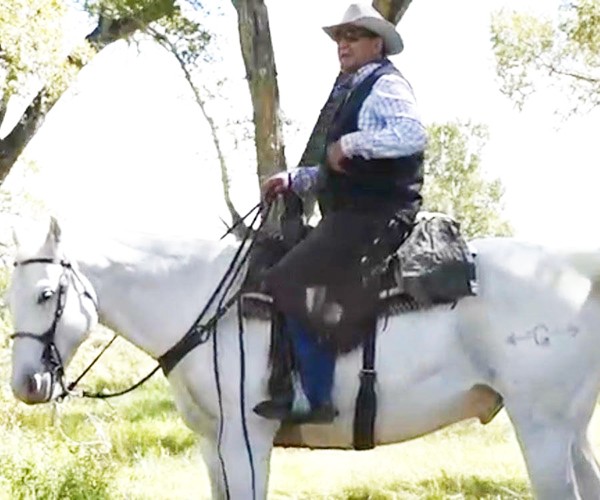Voices of the Valley features rancher Gary Sandoval

VALLEY — The Voices of the Valley is an oral history project by the Sangre de Cristo National Heritage Area (SdCNHA) that explores and documents the relationship between culture and natural resources in the San Luis Valley, placing emphasis on the particular meanings that inhabitants associate with the communities they live in. SdCNHA would like to share some of Gary Sandoval’s oral history. The complete interview can be seen at SdCNHA’s YouTube Channel: SangreNHA.
Gary Sandoval grew up as the son of the foreman of the prominent T-Bone ranch, which is located about 10 miles east of Antonito. Gary enjoyed growing up in the ranching lifestyle, watching his father work hard. The T-Bone ranch had a summer grazing ground in Vallacito, NM where Gary has fond memories of working with his dad, the horses and life by the streams. Each day he could hardly wait to get up and get going, and this instilled in him a love of ranching.
He knew that to become a rancher he would have to work hard to save up some money, so Gary decided to work in the Perlite mines to save money. The Perlite mines were hard and physical work and he noticed that most Hispanics were given the hard labor jobs while the whites were given the jobs of running machinery. He did not take much offense to this as he was focused on working hard, saving money and starting a ranch within his goal of five years time. After nine years of hard work at the mines he was not able to catch up enough financially to be able to purchase his own land and cattle outright and decided to look at other means to make his ranch a reality.
Gary was aware that the FHA was now in the area and was offering loans to ranchers. The first time he visited a loan officer was with his father. He remembers the respect people showed to his father for his outstanding work at the T-Bone Ranch. He did not get the loan due to “lack of experience”, which surprised Gary since he had spent his whole life around ranching. Gary didn’t give up and continued to go on his own to ask for a loan. In one initial interview he asked for financing for 200 acres and 50 head of cattle and machinery. The loan officer said that adding machinery into the loan would make it very large and improbable. Gary returned home and spoke with his father who suggested going back to the loan officer and asking for just the land and cattle and Gary could use his father’s equipment. The loan officer met him once again and said they would let him know. A letter came in the mail saying that he didn’t qualify.
Gary did not lay blame on the FHA at this point. He just figured that was the way it was, and he would just keep working on his ranching dream little by little. He would gain the experience they were asking for by starting small. He used the money he had to raise 10 head of cattle successfully for some time. He went back to apply for a loan. He was again denied.
Gary and his brother were team ropers and had built a friendship with the two loan officers who made up another roping team. Gary went to them in their offices to apply for yet another loan. They told Gary they weren’t taking applications because there was no money available. He took the loan officers at their word, that there were no funds, until he started talking with his Anglo friends who were getting numerous loans from FHA. They encouraged Gary to go back and apply, but Gary was always told there was no money.
Through a contact from the Perlite mine, Gary become aware of a different loan he could apply for through the credit union. He applied and got the $15,000 loan at 11 percent interest. The FHA interest rate would have been 3-4 percent. At this point Gary was able to start his ranch, but had to continue working at the perlite mines and had to take another job bucking bales to keep up with the payments at that interest rate. He never missed a payment.
Through coffee shop talk, the ranchers began to notice a very noticeable trend in loans awarded in the San Luis Valley and in northern New Mexico. The Hispanic ranchers were getting no loans from the FHA while their Anglo friends were getting numerous large loans. This was noticeable at the grazing grounds and at the sale. This was when they first began to piece together that they were being discriminated against, and they banded together to create change through the Garcia v. Vilsack lawsuit. The process was complicated and it required much documentation that was missing or lost over time. Richard Gomez, who had worked for the FHA home loans and was now retired, encouraged his friends not to give up their pursuit. He volunteered his knowledge on the side of the Hispanic ranchers in preparation for their case. In the end the case took a long time to resolve and many ranchers were unable to regain their losses while the few that had the necessary documentation did gain some financial retribution.
In the end Gary states that ranching has to be in your heart, and it sure is still in his.
To watch Gary’s oral history video, learn more about SdCNHA and their oral history project, Voices of the Valley, or to nominate someone to be interviewed visit www.sdcnha.org, email [email protected] or call (719) 588-4070.



